Queen Elizabeth's Most Meaningful Outfits
Every look told a story.


Queen Elizabeth II's wardrobe is an encapsulation of history. Every outfit she wore told a story, reflecting her role as monarch, her style, and her leadership. From the colorful ensembles that made her visible in a crowd of thousands to the meticulous choice of fabrics and accessories, her clothing was an extension of her identity, diplomacy, and commitment to her people. Ahead, the most meaningful outfits that defined her legacy.
Royal Ascot Hats

At the prestigious Royal Ascot race, the Queen’s hats were as much of an event as the horses themselves. From extravagant designs to whimsical embellishments, everyone knows the best part of a derby is the hats, and the Queen made no exception. Every time, her hats captured the fun and flair of this iconic event, while still being refined enough to not alarm the royal legacy. But either way, she was always there to see the horses and wear a fun hat—in that order.
Royal Christening Gown

There is a royal family tradition when it comes to christenings. Queen Elizabeth (seen here with Princess Anne) upheld a family tradition by using a gown first worn by the Queen's great-great-grandmother Queen Victoria’s children. The royal christening gown was passed down through generations, representing continuity, legacy, and the enduring strength of the monarchy. It was more than a dress—it was history in the making.
Prince Philip, Duke of Edinburgh's Funeral, 2021
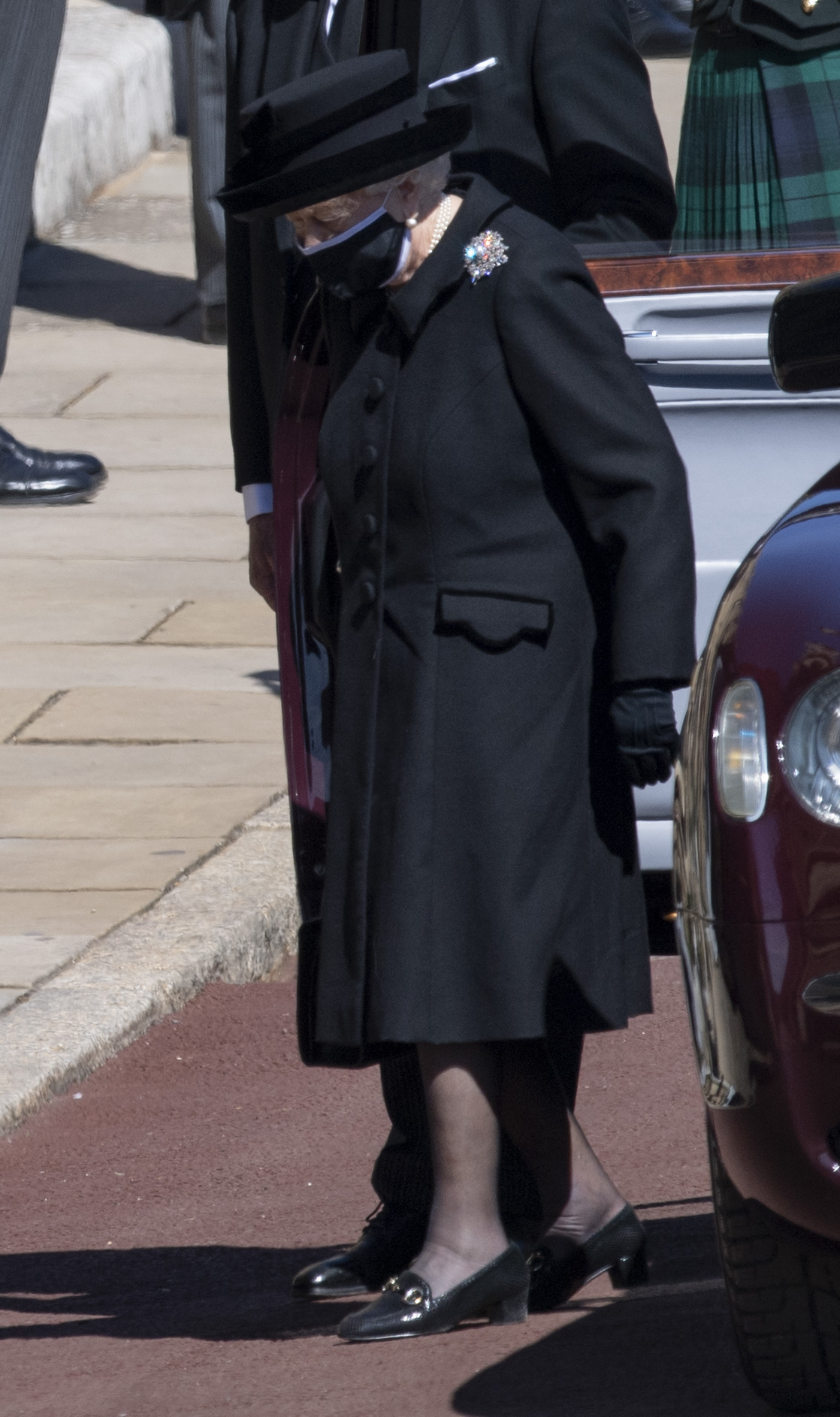
In a somber yet dignified tribute to her husband, Queen Elizabeth wore a black coat and hat paired with her signature pearl necklace to Prince Philip’s funeral in 2021. The outfit reflected a moment of personal loss, but also royal strength and resilience—alongside her mask, it is a reflection of everything she endured in her reign, including a pandemic. Her ensemble was a symbol of mourning, grace, and the deep bond shared between the Queen and her late husband and consort.
Tour of Canada, 1959

In 1959, the Queen’s red-and-white gown during her Canada tour was a striking nod to the country's national flag, blending her royal style with a little bit of patriotic flair. This ensemble was a stylish way to honor the country and its people with a vivid color palette while maintaining regal composure. This was one of several trips to Canada the Queen took, having taken 22 visits to the country between 1951 and 2010—the most of any member of the royal family.
India Tour, 1961
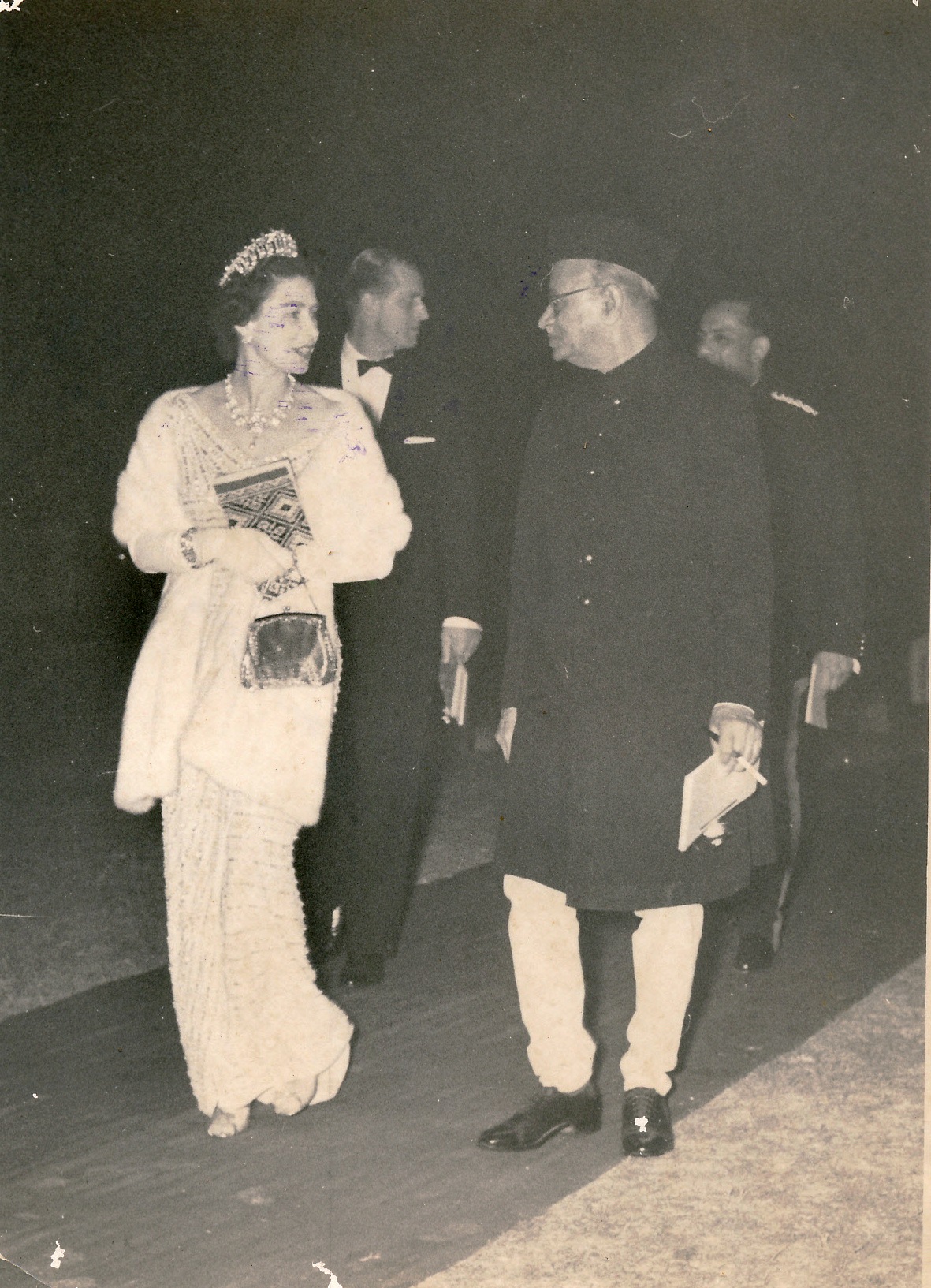
On her 1961 tour of India, Queen Elizabeth embraced the local culture with vibrant, lightweight fabrics and bright colors. Her wardrobe was a mix of royal tradition and respect for Indian customs, ensuring she blended in while still standing out. This was the Queen's first visit to India, and upon her arrival, nearly a million people awaited her arrival along the route from the airport in Delhi to the official residence of the Indian president.
The Queen’s Brooches

The Queen’s collection of brooches, including the legendary Cullinan III and IV, were as iconic as her reign itself. Each brooch was a symbol of history and personal significance, often worn during important events to convey meaning beyond words. These sparkling jewels became part of the Queen’s signature look, sparkling in the distance and telling a story of legacy, family, and the enduring strength of the monarchy with every wear. I'd wear it every day, too.
Get exclusive access to fashion and beauty trends, hot-off-the-press celebrity news, and more.
The Rainbow Wardrobe

The Queen’s wardrobe was an explosive rainbow of vibrant, attention-grabbing colors, designed to ensure she stood out in any crowd. From neon greens to royal blues and canary yellows, her colorful ensembles were all about visibility. Even this bright orange pastel floral-patterned suit ensures that she made her presence known wherever she went, even though she's also literally the Queen. But a girl's gotta do what a girl's gotta do, right? Even if she's royalty.
Poppy Dress (Remembrance Day)

For Remembrance Day, a memorial day observed in Commonwealth member states to honor late members of the armed forces who passed in the line of duty, the Queen often wore a black dress paired with a red poppy pin—both elegant and deeply symbolic. This outfit was her quiet tribute to the fallen soldiers. The simplicity of the dress and the significance of the poppy pin spoke volumes, honoring both the past and the enduring sacrifices made by so many.
Trooping the Colour Outfits

The Queen, just like us, wants to make sure she stands out on her birthday. She was doing Birthday Outfits before we even knew they were a thing. Trooping the Colour, or "Queen's Birthday Parade", marks the celebration of the British sovereign with an annual parade, and The Queen took it very seriously. Her color-blocked ensembles—bright reds, vibrant blues, and lively yellows—were designed for maximum impact, ensuring she was seen clearly by the thousands of cheering citizens.
COVID-19 Broadcast, 2020

During the 2020 COVID-19 crisis, the Queen wore a green dress for a rare televised broadcast to the citizens of the United Kingdom ahead of unforeseeable times — green being a color that symbolized hope and resilience. The dress was simple, yet poignant, accompanied by her signature pearl earrings and necklace, and an opal brooch. This marked a subtle signal that even in the darkest times, the Queen stood firm, ready to offer comfort and guidance to her people.
Scottish Tartan
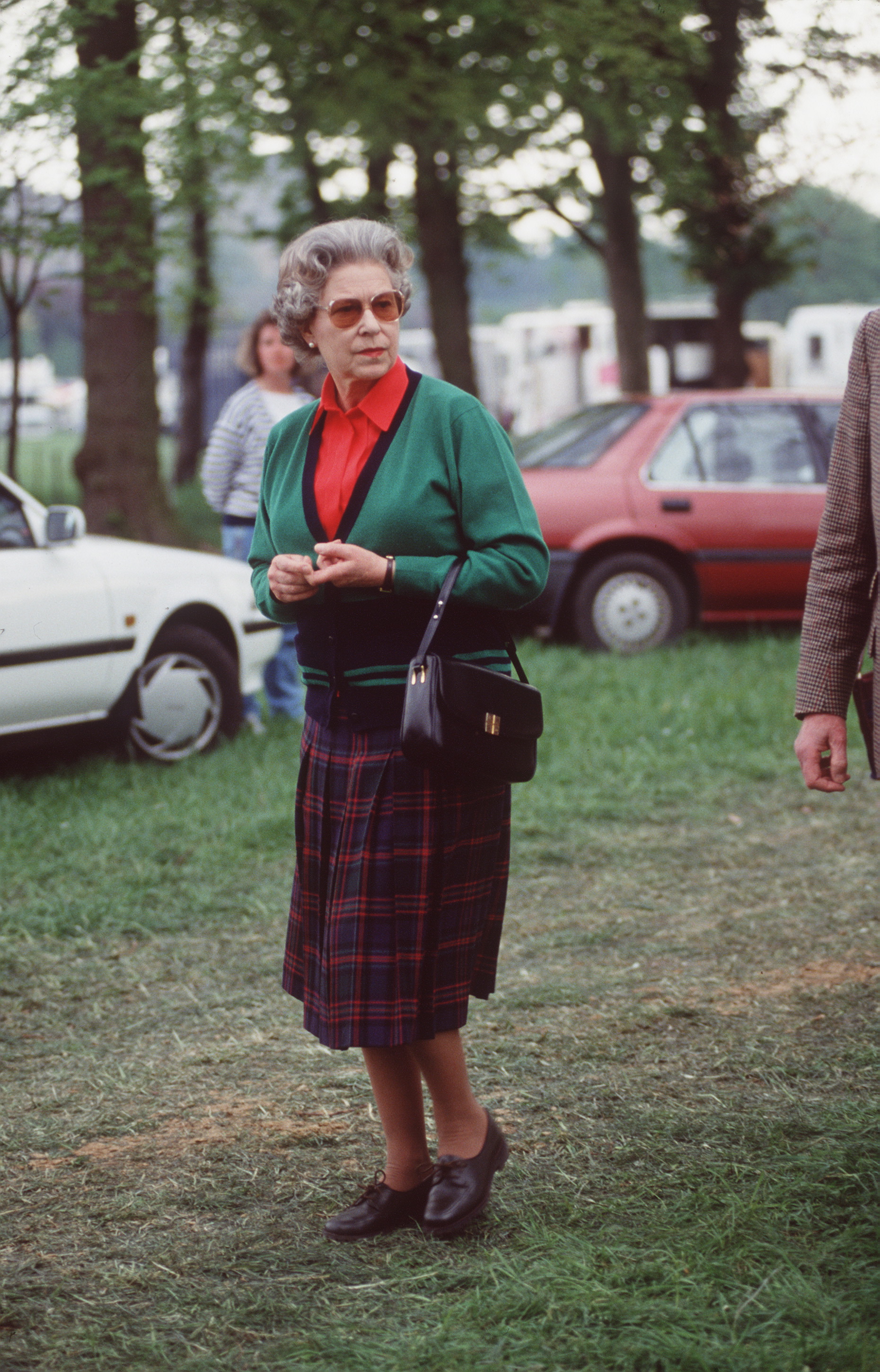
During her visits to Balmoral, her summer estate in Aberdeenshire, Scotland, the Queen often wore Scottish tartan—an ode to her deep connection to Scotland and its traditions. Having spent much of her childhood at Glamis Castle in Angus with her maternal grandparents or at Balmoral, she often reflected her admiration in her clothing. These tartan pieces were the perfect marriage of heritage and modernity, and represented a deep knowledge of her family's history.
Platinum Jubilee Purple Ensemble, 2022

For her final major public appearance before her passing in 2022, Queen Elizabeth wore a regal pastel violet ensemble to the Platinum Jubilee—a fitting tribute to her 70-year reign. The color purple, long associated with royalty, symbolized both her enduring legacy and the memories of her reign. This outfit wasn’t just about style; it was a symbol of the Queen’s remarkable life of service and grace, as she left an unforgettable mark on history.
Olympics Opening Ceremony, 2012

At the 2012 London Olympics Opening Ceremony, the Queen made a grand entrance in a peach-colored dress, matching hat, and an unforgettable James Bond cameo that ended with her jumping out of a helicopter, only to appear in the stadium, as if she had just come from meeting with Bond himself. Her look was stylish, refined, and just the right amount of playful, capturing the spirit of the games while giving a cheeky nod to British culture. It was fashion, fun, and a bit of cinematic history all rolled into one.
Japanese Pearls Four-Strand Choker Necklace

When Queen Elizabeth first attended a state visit to Japan in 1975, the country's government gifted her a set of very fine Japanese cultured Akoya pearls. She would go on to ask her court jeweler to set the pearls on a four-strand choker necklace with a diamond clasp. This four-strand pearl necklace veered differently from her signature three-strand necklace, and especially since she didn't often wear choker-style necklaces. She would go on to wear this necklace to an official visit to Bangladesh in 1983, at former Prime Minister Margaret Thatcher’s 70th birthday in 1995 and at a banquet at the Chinese Embassy in London, in 1995. She also loaned it at a point to her former daughter-in-law, the late Princess Diana, as well as to her granddaughter-in-law, Princess Katherine.
Jubilee Ensembles

Over the course of her 70-year reign, the anniversary of the Queen's coronation was celebrated with five Silver, Golden, Diamond, and Platinum Jubilees. In honor of the major event, the Queen's outfits had to represent her longevity and unwavering reign. Each dress reflected not just the occasion, but the sense of continuity, history, and grace that defined Her Majesty. Whether celebrating 25 years or 70, the Queen’s ensembles always embodied resilience, timelessness, and a commitment to royal tradition.
Commonwealth Day Outfits

Commonwealth Day, or the celebration of the 56 nations in the Commonwealth, is celebrated yearly on the second Monday in March. And it was a big day for Queen Elizabeth II: Almost every year of her reign, she sent a special message to the people of the Commonwealth and attended Commonwealth Day celebrations in London, including a service at Westminster Abbey. Because the day is all about unity and global cooperation, the Queen often found herself in varying shades of red, white, or blue—the colors of the Commonwealth, showing her respect and dedication to the collective.
Princess Anne’s Wedding, 1973

At the wedding of Princess Anne and Captain Mark Phillips, Queen Elizabeth broke from her usual pastel palette and embraced a vibrant cobalt blue coat and matching hat. It was a departure from her more muted or pastel shades, but the look was just as regal: joyful, celebratory, and utterly chic for her only daughter's wedding. The outfit demonstrated the Queen’s personal touch of style and her ability to mix tradition with a dash of modern flair.
Meeting JFK and Jackie, 1961

When the Queen invited President John F. Kennedy and First Lady Jackie Kennedy to Buckingham Palace in 1961, she wore a teal blue tulle ball gown that perfectly matched the elegance of the occasion. The meeting between these icons of the 20th century wasn’t just about diplomacy; it was about style, too. The Queen's poised look embodied regal grace, while subtly signaling a burgeoning relationship between two leaders of the UK and the U.S.
Coronation Gown, 1953

Norman Hartnell’s design for the Queen’s coronation was pure British elegance. The white satin gown, embroidered with national symbols and embellished with jewels, the gown radiated regal splendor and a connection to the Commonwealth. This wasn’t just a dress—it was a statement, one that showcased the new Queen’s authority. The queen would wear this gown for the State Opening of Parliament, paired with the Imperial State Crown.
Prince Charles and Camilla's Blessing, 2005
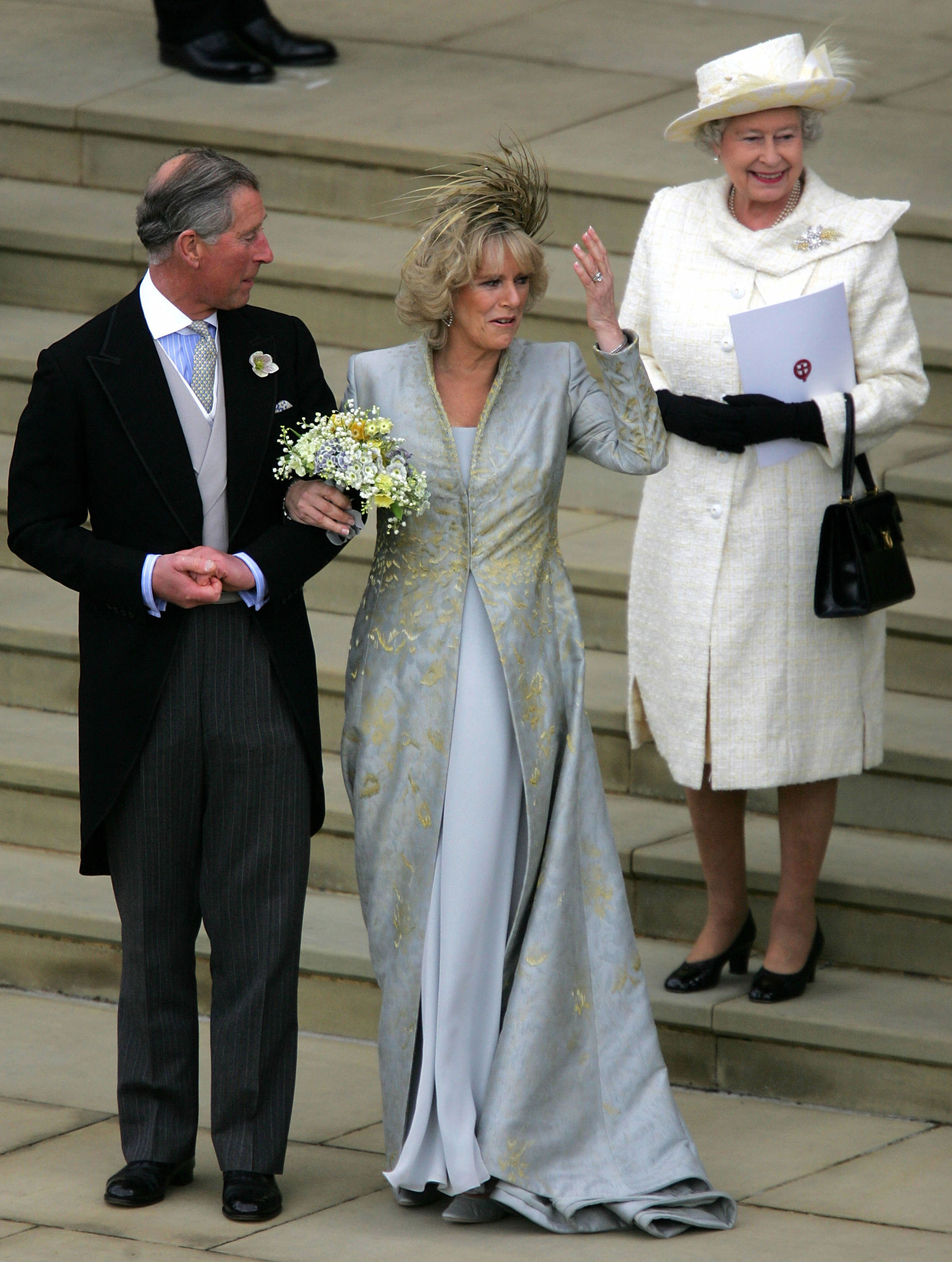
Queen Elizabeth's outfit at the blessing of future King Charles and Camilla Parker Bowles symbolized continuity and royal tradition. The all-white ensemble—it's totally okay to wear white to someone else's wedding if you're The Queen, and only if you're the Queen—paired with a matching hat, represented calm, strength, and dignified support. The groom's parents did not attend the civil wedding ceremony due to her position as head of the Church of England and their rules about re-marriage, but came to celebrate at their Service of Prayer and Dedication at St. George's Chapel in Windsor Castle, and held a reception following.
Wedding Dress, 1947

The Queen’s gown for her 1947 wedding to Prince Phillip was a stunning piece of fashion history. Royal Warrant as Dressmaker Norman Hartnell designed the ballgown, which was made of Chinese silk and adorned with 10,000 pearls, a sweetheart neckline, and a casual 13-foot train. This true masterpiece was a royal declaration of optimism and love for the then-Princess, capturing the spirit of renewal. Due to a ration on clothing due to the war, Princess Elizabeth's fabrics had to be acquired through clothing ration coupons.
Prince Harry and Meghan Markle’s Wedding, 2018

For Harry and Meghan’s wedding in 2018, the Queen wore a bright lime, almost chartreuse green coat and matching pillbox hat—an outfit that radiated hope and renewal for the extremely public-facing couple. The color choice was subtle but powerful, symbolizing the start of a new chapter for the royal family. This dress was about looking forward, embracing the future with grace as the royal family shifted into the new era, while still holding true to the timeless elegance that has defined the Queen’s reign.
Prince Charles and Diana’s Wedding, 1981
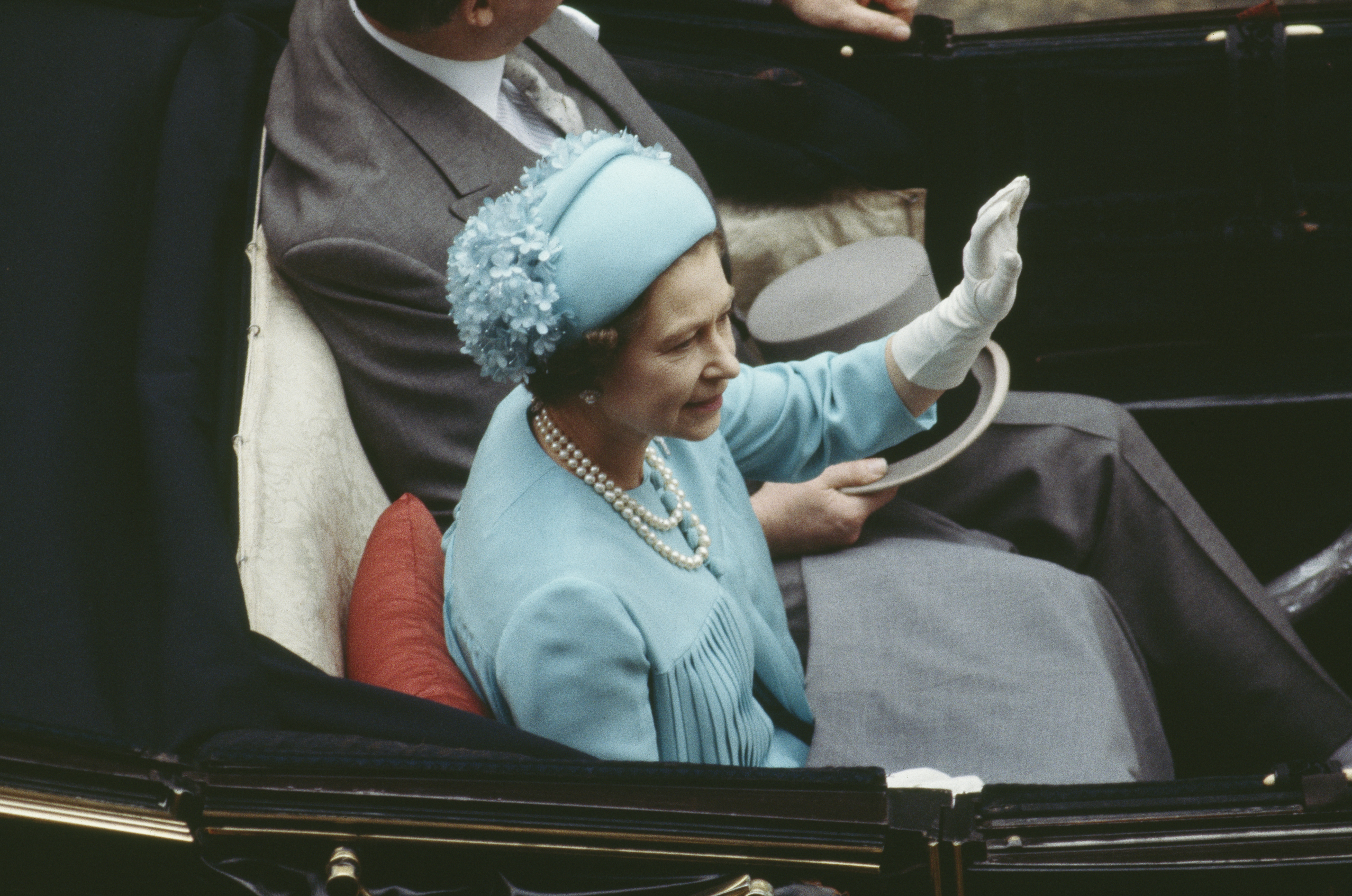
At Prince Charles and Princess Diana’s wedding in 1981, the Queen wore a bold blue-and-turquoise fringed ensemble that exuded royal pride. The color combination reflected both her joy for her son's wedding and her sense of duty. As a mother and a monarch, she perfectly balanced her pride in her son’s marriage with her role as the head of state. Unfortunately, having the Queen at your wedding in blue didn't seem to be the good luck charm one would have you think. Queen Elizabeth wore blue to several royal weddings—including her sister, Princess Margaret’s wedding, as well as the weddings of her three children—that eventually ended in divorce.
Ireland State Visit, 2011

For her 2011 visit to Ireland—the first by a monarch since 1911 by Elizabeth's grandfather King George V, when the entire island of Ireland was still part of the United Kingdom of Great Britain and Ireland—the Queen wore a dress designed by Angela Kelly. The color green is a subtle yet powerful tribute to Ireland, embodying unity and healing. Here, she's visiting the historical site the Rock of Cashel in Cashel, County Tipperary, on her way to Cork at the end of her trip.
Pearl Necklaces

Queen Elizabeth’s signature three-strand pearl necklace was more than just an accessory: it was a symbol of her poise, grace, and royal dignity. Worn almost daily throughout her reign, the pearls became a beloved part of her look, and she had a vast collection of pearl necklaces. Her favorite, however, was a three-strand classic design made from heirloom family pearls. Her love of pearls stemmed from a family tradition started by her great-great-grandmother, Queen Victoria, where each of her daughters and granddaughters were gifted a pearl every year on their birthday so that by the time they were 18, they would have enough pearls for a necklace.
The Launer Handbag

No Queen Elizabeth II look was complete without her trusted Launer handbag. Always by her side, this practical yet stylish accessory became an integral part of her ensemble. Having been gifted the bag from her mother, Queen Elizabeth The Queen Mother, the devotion started from there. In the 1950s, the Queen purchased her own Launer bag, and gave Launer London a royal warrant in 1968. By 2019, she owned more than 200 of their bags, according to CEO and owner Gerald Bodmer—and she also kept all of her mother's Launer bags, too.

During her 1986 state visit to China, Queen Elizabeth chose a floral ensemble that was both diplomatic and stunning. The design, with its intricate patterns and vibrant yellow hue, was a nod to Chinese culture, showcasing the Queen’s respect for her hosts. The reason this state visit was so important was that it signified a strengthening of relations between Britain and the People’s Republic of China, and marked the first visit of a British sovereign to China.
Visit to the United States, 1957

At the final event for her 1957 visit to the United States, the Queen wore a classic white gown paired with a tiara, signaling elegance and diplomacy. During her stay Queen Elizabeth II and Prince Philip stayed with President Dwight Eisenhower and First Lady Mamie Eisenhower for four days in the White House, making this the second time a British monarch had slept in the White House. They were in attendance for a visit to Virginia for the commonwealth's 350th anniversary celebration of the founding of Jamestown.
Pastel Coats and Hats

When spring arrived, the Queen was ready with her signature pastel coats and matching hats, which became as synonymous with the season as créme-filled eggs and the Easter Bunny. Soft, elegant, and always in tune with nature’s palette, these outfits were perfect for royal garden parties and Easter services. The Queen’s approach to spring fashion was always understated but impactful, embodying grace and warmth as she mingled with the public.
Annual Christmas Broadcast

Every year, the Queen’s Christmas broadcast address was a key part of the festive season. Often paired with her symbolic brooches and delivered to the country from behind her royal During WWII, Queen Elizabeth served in the Auxiliary Territorial Service, and her uniform was a symbol of her dedication to the war effort. She wore the military-style attire with pride, proving that even in times of crisis, duty and service come first. This ensemble wasn’t just a uniform; it was a powerful statement of resilience, as the future Queen showed her commitment to both her country and her people. The Queen’s Christmas message was always a moment of reflection, and her attire underscored the importance of tradition, family, and duty. Here, in what would be her final Christmas message, the Queen marked the death of her consort, Duke of Edinburgh earlier in the year, remarking that "although it's a time of great happiness and good cheer for many, Christmas can be hard for those who have lost loved ones. This year, especially, I understand why," also referring to the ongoing COVID-19 pandemic.
Wartime Uniform, 1945

During World War II, then-Princess Elizabeth served the Commonwealth in the Auxiliary Territorial Service, and her uniform was a symbol of her dedication to the war effort. As the first female member of the royal family to join the armed services, she wore the military-style attire with pride, proving that even in times of crisis, duty, and service come first. Little did the future Queen know that she would also be the last surviving head of state to have served in World War II.
Addressing the United States Congress, 1991

In 1991, Queen Elizabeth II became the first monarch to address a joint session of the U.S. Congress, delivering a historic address that celebrated the cooperation and commonality of both countries. Her speech, a blend of diplomacy and personal warmth (and a few laughs) highlighted her deep admiration for the United States and its people. The moment was not just a formal occasion—it symbolized the enduring bond between two nations, with the Queen's words resonating far beyond politics, reflecting her unique role on the world stage.
Amanda Mitchell is a writer and podcaster with bylines at Marie Claire, OprahMag, Allure, Byrdie, Stylecaster, Bon Appetit, and more. Her work exists at the apex of beauty, pop culture, and absurdity. A human Funfetti cake, she watches too much television, and her favorite season is awards season. You can read more of her work at amandaelizabethmitchell.com or follow her on Instagram and Twitter @lochnessmanda.
